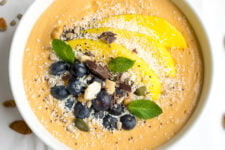If you enjoy the occasional breakfast smoothie, or maybe if you’re an everyday smoothie drinker, then you likely are accustomed to throwing a banana or two into your blender alongside your other favorite smoothie ingredients. Not only does a banana help you achieve a thicker smoothie texture, but it also provides a bevy of health benefits … right?

Well, some surprising research has recently been released that indicates you might actually want to hold off on the bananas in your smoothies moving forward.
The research, courtesy of the University of California, Davis, sought to understand the relationship between polyphenol oxidase and flavanols. Polyphenol oxidase is an enzyme found in many fruits and veggies, and it’s what causes certain fruits and vegetables to brown under certain conditions (like when you cut an apple and expose the interior flesh to oxygen). Flavanols are healthful compounds that have been found to offer antioxidative and anti-inflammatory properties.
The research discovered that, when you eat fruits like bananas that are high in polyphenol oxidase activity, it significantly lowers the amount of flavanols your body can absorb. In other words, if you’re blending a smoothie with multiple ingredients, including bananas, you likely won’t be getting all the health benefits you could from those other ingredients (high-flavanol ingredients that often find their way into smoothies include berries and cocoa).
And it’s not just bananas you have to watch out for! While the research specifically studied bananas, researchers said that other foods high in polyphenol oxidase activity, like some greens, can have the same result.
The Academy of Nutrition and Dietetics advises consuming 400–600 milligrams of flavanols daily for your cardiometabolic health; so, if you’re always combining your flavanol-rich foods with bananas or greens, you could be severely decreasing the amount of flavanols you’re actually absorbing. To absorb the most flavanols possible, the researchers on this study recommended making a smoothie with those high-flavanol foods you’re already using (like berries), but then combining them with only low-polyphenol oxidase foods, like pineapples, mangoes, oranges or yogurt.

Build a Better Smoothie
If you want to reap the myriad health benefits of bananas, enjoy your banana on its own. If you want to build a better, banana-free smoothie, though, consider one of the following options:
- This immune-boosting green smoothie made with spinach, ginger, dates, oranges, lemon and turmeric powder
- This cucumber sorrel smoothie made with cucumbers, sorrel or mint leaves, and Greek yogurt
- This persimmon smoothie, made with persimmons, coconut milk, ginger, and cardamom
Also, if you’re relying on bananas to give your smoothie a better, thicker texture, don’t! A smoothie’s texture is all about the ratios. So, if you’re using unfrozen fruit in your smoothie, use less liquid. If you’re using frozen fruit in your smoothie, use more liquid. You might also consider making a smoothie bowl rather than a traditional smoothie. Smoothie bowls are made with less liquid and are designed to be eaten with a spoon rather than slurped through a straw.






